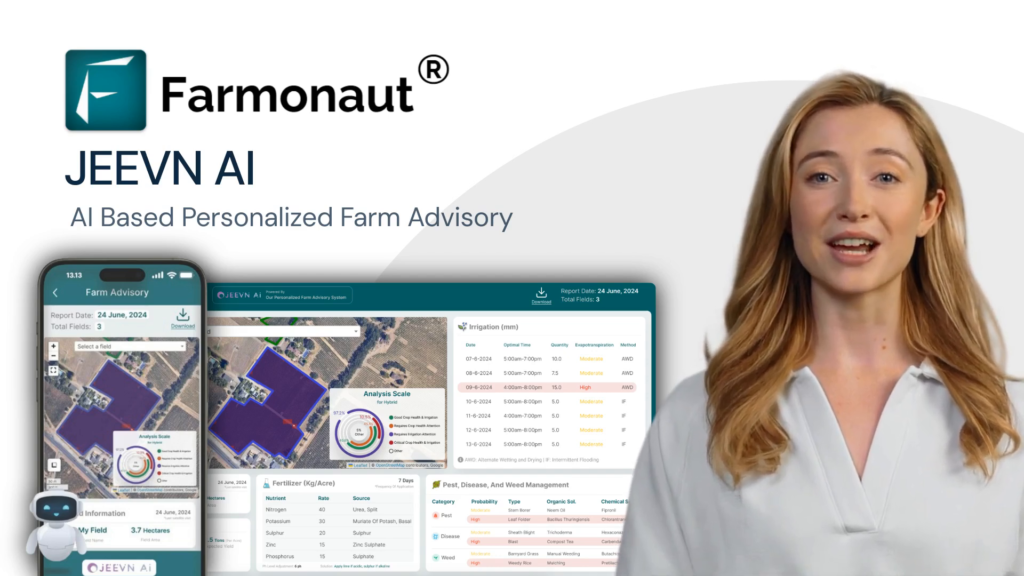Unlocking Profitability: Illinois Dairy Farm Management Tools for Cost Analysis and Financial Planning
“Illinois dairy farms can reduce costs by up to 20% through effective financial planning and management tools.”
Welcome to our comprehensive guide on dairy farm profitability and milk production costs in Illinois. As representatives of Farmonaut, we’re excited to delve into the intricate world of agricultural economics and provide you with valuable insights for farm management and financial decision-making. In this blog post, we’ll explore the various tools and strategies available to Illinois dairy farmers to optimize their operations and boost profitability.

The Importance of Financial Planning in Dairy Farming
In the ever-evolving landscape of agriculture, dairy farmers in Illinois face numerous challenges. From fluctuating milk prices to rising input costs, maintaining a profitable operation requires careful planning and strategic decision-making. That’s where financial planning tools come into play.
At Farmonaut, we understand the critical role that data-driven insights play in modern farming. Our satellite-based farm management solutions provide real-time information on crop health, weather patterns, and resource allocation. While we don’t directly offer dairy-specific tools, our technology can be invaluable for dairy farmers who grow their own feed crops.
Understanding Milk Production Costs in Illinois
Before we dive into the management tools, let’s take a closer look at the cost structure of milk production in Illinois.
“The average milk production cost in Illinois fluctuates between $16 and $22 per hundredweight, impacting farm profitability.”
This cost range highlights the importance of efficient management and cost control in maintaining a profitable dairy operation. Let’s break down the major cost categories:
- Feed costs: Typically the largest expense, accounting for 40-60% of total production costs.
- Labor: The second-largest expense, usually ranging from 10-20% of total costs.
- Equipment and facilities: This includes depreciation, repairs, and maintenance, often accounting for 10-15% of costs.
- Veterinary and medicine: Essential for herd health, these expenses typically make up 3-5% of total costs.
- Utilities: Including electricity, water, and fuel, usually accounting for 3-6% of costs.
- Other costs: This category includes items such as insurance, marketing, and miscellaneous expenses.
Understanding these cost categories is crucial for effective financial planning and management. Now, let’s explore some of the tools available to Illinois dairy farmers for cost analysis and financial planning.
Essential Management Tools for Illinois Dairy Farmers
1. Dairy Profitability Model
The Dairy Profitability Model is an invaluable tool for farmers looking to optimize their operations. This model allows you to input various parameters of your dairy farm and analyze their impact on overall profitability.
Key features of the Dairy Profitability Model include:
- Milk production simulation based on herd size and individual cow productivity
- Feed cost calculator integrating various ration components
- Labor cost estimation tools
- Fixed cost allocation for equipment and facilities
- Revenue projections based on milk price forecasts
By utilizing this model, Illinois dairy farmers can gain a comprehensive understanding of their farm’s financial health and identify areas for improvement.
2. Cost of Feedstuffs Calculator
Given that feed costs represent the largest expense for dairy farms, having a reliable tool to analyze and optimize these costs is crucial. The Cost of Feedstuffs Calculator helps farmers make informed decisions about their feed procurement and ration formulation.
This tool allows you to:
- Compare costs of different feed ingredients on a nutrient basis
- Analyze the impact of market price fluctuations on your feed costs
- Optimize ration composition for cost-effectiveness without compromising nutritional value
- Project feed costs based on herd size and production goals
By leveraging this calculator, Illinois dairy farmers can potentially reduce their feed costs while maintaining or even improving milk production.
3. Farm Financial Planning Spreadsheets
Comprehensive financial planning is essential for long-term success in dairy farming. Various institutions, including the University of Illinois Extension, offer farm financial planning spreadsheets tailored to the needs of Illinois dairy farmers.
These spreadsheets typically include:
- Cash flow projections
- Balance sheet templates
- Income statement generators
- Break-even analysis tools
- Debt repayment capacity calculators
While these tools are invaluable, it’s important to note that they require accurate data input for meaningful results. This is where Farmonaut’s satellite-based crop monitoring can play a crucial role for dairy farmers who grow their own feed crops.
Explore Farmonaut’s API for advanced data integration
Leveraging Technology for Improved Farm Management
In today’s digital age, technology plays a crucial role in farm management. At Farmonaut, we’re at the forefront of this technological revolution in agriculture. While our primary focus is on crop monitoring and management, many of our tools can be adapted to support dairy farm operations, especially for those farmers who grow their own feed crops.

Satellite-Based Crop Monitoring for Feed Production
Many dairy farms in Illinois grow their own feed crops to reduce costs and ensure quality. Farmonaut’s satellite-based crop monitoring system can provide valuable insights for these operations:
- Real-time crop health monitoring: Our NDVI (Normalized Difference Vegetation Index) analysis helps farmers track the health of their feed crops throughout the growing season.
- Soil moisture tracking: Optimal irrigation management is crucial for maximizing yield and minimizing costs.
- Weather forecasting: Access to accurate weather predictions allows for better planning of field operations.
- Yield estimation: Early yield estimates can help in planning feed inventory and making purchasing decisions.
By integrating these technologies into their operations, Illinois dairy farmers can optimize their feed production, potentially reducing one of their largest cost factors.
Financial Risk Management in Dairy Farming
Managing financial risk is a critical aspect of running a successful dairy farm in Illinois. Let’s explore some key strategies and tools for effective risk management:
1. Milk Price Risk Management
Milk price volatility can significantly impact a dairy farm’s profitability. Here are some tools and strategies to manage this risk:
- Futures and options contracts: These financial instruments allow farmers to lock in future milk prices, providing a hedge against market fluctuations.
- Forward contracts: Agreements with processors or cooperatives to sell milk at a predetermined price for a specific period.
- Dairy Margin Coverage (DMC) program: A risk management tool offered by the USDA that provides protection when the difference between the all-milk price and the average feed cost falls below a certain dollar amount selected by the producer.
2. Input Cost Risk Management
Managing the risk associated with input costs, particularly feed, is crucial for maintaining profitability:
- Feed purchasing strategies: Utilizing tools like the Cost of Feedstuffs Calculator to make informed decisions about when and how much feed to purchase.
- Growing own feed: For farms with available land, growing feed crops can provide more control over input costs. Farmonaut’s crop monitoring tools can be particularly useful in this aspect.
- Futures contracts for feed: Similar to milk price hedging, farmers can use futures contracts to lock in prices for feed ingredients.
3. Insurance Products
Various insurance products are available to help Illinois dairy farmers manage risk:
- Livestock Gross Margin (LGM) Insurance for Dairy Cattle: This insurance product provides protection against loss of gross margin (market value of milk minus feed costs).
- Crop insurance: For dairy farmers growing their own feed, crop insurance can provide protection against yield losses due to natural disasters or price declines.
- Property and casualty insurance: Protects against losses to farm buildings, equipment, and livestock due to various perils.
Implementing a comprehensive risk management strategy using a combination of these tools can help Illinois dairy farmers navigate market uncertainties and maintain financial stability.
Sustainable Dairy Practices for Long-Term Profitability
Sustainability is not just an environmental concern; it’s also a key factor in long-term profitability for dairy farms. Let’s explore some sustainable practices that can benefit Illinois dairy farmers:
1. Energy Efficiency
Implementing energy-efficient practices can significantly reduce operational costs:
- Installing energy-efficient lighting and ventilation systems
- Using heat recovery systems to capture and reuse waste heat from milk cooling
- Exploring renewable energy options such as solar panels or anaerobic digesters
2. Water Conservation
Efficient water use can reduce costs and improve sustainability:
- Implementing water recycling systems for cleaning and cooling
- Using precision irrigation techniques for feed crop production
- Regular maintenance of water systems to prevent leaks and waste
3. Manure Management
Proper manure management can turn a potential environmental liability into an asset:
- Using manure as fertilizer for feed crops, reducing the need for chemical fertilizers
- Implementing anaerobic digestion systems to produce biogas for energy
- Exploring composting options for additional revenue streams
4. Herd Health and Welfare
Prioritizing animal health and welfare can lead to increased productivity and reduced veterinary costs:
- Implementing regular health check-ups and preventive care programs
- Optimizing cow comfort through improved housing and bedding
- Using data analytics to monitor individual cow health and performance
By integrating these sustainable practices, Illinois dairy farmers can not only reduce their environmental impact but also improve their long-term profitability.
Comparative Cost Analysis for Illinois Dairy Farms
Understanding how your farm’s costs compare to industry benchmarks is crucial for identifying areas of improvement. Here’s a comprehensive breakdown of costs associated with dairy farm management in Illinois:
| Cost Category | Fixed Costs (Annual) | Variable Costs (per cow) | % of Total Costs | Industry Benchmark |
|---|---|---|---|---|
| Feed | $50,000 | $1,800 | 50% | 45-55% |
| Labor | $100,000 | $500 | 15% | 12-18% |
| Equipment | $75,000 | $200 | 10% | 8-12% |
| Veterinary | $20,000 | $150 | 5% | 3-7% |
| Utilities | $30,000 | $100 | 4% | 3-6% |
| Other | $40,000 | $250 | 16% | 10-20% |
| Total | $315,000 | $3,000 | 100% | – |
This table provides a clear, visually appealing representation of cost structures, enabling you to quickly identify areas for potential improvement. Compare your farm’s performance against these industry standards to pinpoint where you might be able to reduce costs or improve efficiency.
Leveraging Market Dynamics for Improved Profitability
Understanding and responding to market dynamics is crucial for maximizing profitability in the Illinois dairy industry. Let’s explore some key aspects:
1. Milk Price Trends
Keeping abreast of milk price trends can help in making informed decisions about production levels and risk management strategies. Some key factors to monitor include:
- Global supply and demand for dairy products
- Changes in consumer preferences (e.g., shift towards plant-based alternatives)
- Policy changes that might affect milk prices
- Seasonal variations in milk production and consumption
2. Consumer Preferences
Adapting to changing consumer preferences can open up new market opportunities:
- Growing demand for organic and grass-fed dairy products
- Increased interest in local and artisanal dairy products
- Rising popularity of value-added dairy products (e.g., specialty cheeses, probiotic yogurts)
3. Value-Added Products
Diversifying into value-added products can increase revenue streams:
- On-farm processing of milk into cheese, yogurt, or ice cream
- Developing niche products like flavored milk or kefir
- Exploring agritourism opportunities (e.g., farm tours, cheese-making workshops)
By staying informed about these market dynamics and adapting your strategies accordingly, you can position your Illinois dairy farm for long-term success and profitability.
The Role of Technology in Modern Dairy Farming
At Farmonaut, we’re passionate about the role of technology in advancing agriculture. While our primary focus is on crop monitoring, many of the technological advancements in the field can be applied to dairy farming as well. Here are some cutting-edge technologies that are transforming the dairy industry:
1. Precision Dairy Farming
Precision dairy farming uses advanced technologies to monitor individual cows and optimize farm operations:
- Wearable devices: Sensors attached to cows can track activity levels, rumination, and health indicators.
- Automated milking systems: Robots that allow cows to be milked on their own schedule, potentially increasing milk yield and reducing labor costs.
- Smart feeding systems: Automated systems that adjust feed rations based on individual cow needs and production levels.
2. Data Analytics and AI
The power of data analytics and artificial intelligence is being harnessed to improve decision-making on dairy farms:
- Predictive analytics: Using historical data to predict future trends in milk production, cow health, and market prices.
- AI-powered farm management systems: These systems can analyze vast amounts of data to provide actionable insights for farm operators.
- Image recognition: AI-powered cameras can monitor cow behavior, detect heat, and even identify individual cows.
3. Blockchain for Traceability
Blockchain technology is being explored for its potential to improve traceability in the dairy supply chain:
- Tracking milk from farm to consumer, ensuring food safety and quality
- Verifying the authenticity of organic or specialty dairy products
- Streamlining payments and contracts within the supply chain
While Farmonaut doesn’t directly offer these dairy-specific technologies, our satellite-based crop monitoring and AI-powered advisory systems can be valuable for dairy farmers who grow their own feed crops. By leveraging these technologies, Illinois dairy farmers can optimize their operations, reduce costs, and improve overall profitability.
Explore Farmonaut’s API Developer Docs for integration possibilities
Financial Decision-Making Tools for Dairy Farmers
Making informed financial decisions is crucial for the success of any dairy farm. Here are some essential tools that Illinois dairy farmers can use to enhance their financial decision-making process:
1. Enterprise Budgeting Tools
Enterprise budgeting helps farmers analyze the profitability of different aspects of their dairy operation:
- Separate budgets for milk production, heifer raising, and crop production
- Comparison of different production systems (e.g., conventional vs. organic)
- Scenario analysis for changes in input costs or milk prices
2. Capital Investment Analysis Tools
These tools help evaluate the potential return on major investments:
- Net Present Value (NPV) calculators for assessing long-term investments
- Payback period analysis for equipment purchases
- Comparison tools for different financing options
3. Cash Flow Projection Tools
Maintaining a healthy cash flow is essential for day-to-day operations:
- Monthly cash flow projections to anticipate potential shortfalls
- Seasonality adjustments to account for variations in milk production and sales
- Integration with actual financial data for ongoing monitoring
4. Benchmarking Tools
Comparing your farm’s performance to industry standards can highlight areas for improvement:
- Financial ratio analysis (e.g., debt-to-asset ratio, operating profit margin)
- Production efficiency metrics (e.g., milk per cow, feed efficiency)
- Cost structure comparisons with similar-sized farms
By utilizing these financial decision-making tools, Illinois dairy farmers can gain a deeper understanding of their farm’s financial health and make data-driven decisions to improve profitability.
Farmonaut’s Contribution to Agricultural Financial Planning
While Farmonaut’s primary focus is on crop monitoring and management, our technology can play a significant role in supporting the financial planning efforts of dairy farmers who grow their own feed crops. Here’s how our tools can contribute to better financial management:
- Crop Yield Estimation: Our satellite-based monitoring can provide early yield estimates for feed crops, helping dairy farmers plan their feed inventory and make informed purchasing decisions.
- Resource Optimization: By providing insights on crop health and soil moisture, our technology can help farmers optimize their use of inputs like water and fertilizers, potentially reducing costs.
- Risk Management: Our weather forecasting and crop health monitoring can help farmers anticipate and mitigate risks to their feed crops, which directly impacts the farm’s financial stability.
- Data Integration: Through our API, farmers can integrate crop data into their financial planning tools, providing a more comprehensive view of their operation’s financial health.
While we don’t offer dairy-specific financial tools, our technology can provide valuable data inputs that enhance the accuracy and effectiveness of financial planning for dairy farms that include crop production in their operations.
Frequently Asked Questions
Here are some common questions about dairy farm management and financial planning in Illinois:
- Q: What is the average herd size for dairy farms in Illinois?
A: The average herd size for dairy farms in Illinois is around 200 cows, though this can vary significantly from small family farms to large commercial operations. - Q: How often should I review my farm’s financial statements?
A: It’s recommended to review your financial statements monthly, with a more comprehensive analysis quarterly and annually. - Q: What is the Dairy Margin Coverage (DMC) program?
A: The DMC is a voluntary risk management program that offers protection to dairy producers when the difference between the all-milk price and the average feed cost falls below a certain dollar amount selected by the producer. - Q: How can I reduce my farm’s feed costs?
A: Strategies to reduce feed costs include optimizing rations, improving forage quality, considering alternative feed sources, and potentially growing your own feed crops. - Q: What role does technology play in modern dairy farming?
A: Technology plays a crucial role in modern dairy farming, from precision agriculture tools for crop production to automated milking systems and data analytics for herd management.
Conclusion
Navigating the complex world of dairy farm management and financial planning in Illinois requires a combination of traditional wisdom and modern tools. By leveraging the various management tools, risk management strategies, and technological advancements we’ve discussed, Illinois dairy farmers can position themselves for long-term success and profitability.
Remember, while tools and technologies are important, they’re most effective when combined with sound management practices and a deep understanding of your unique farm operation. Continual learning, adaptation, and a willingness to embrace new technologies and practices are key to thriving in the ever-evolving dairy industry.
At Farmonaut, we’re committed to supporting the agricultural community with cutting-edge satellite-based monitoring and management tools. While our focus is primarily on crop production, we recognize the interconnected nature of modern farming operations. For dairy farmers who grow their own feed crops, our technology can provide valuable insights to support both crop management and overall farm financial planning.
We encourage you to explore the various tools and strategies discussed in this blog, and to consider how technologies like those offered by Farmonaut might fit into your farm management approach. Here’s to a profitable and sustainable future for Illinois dairy farms!



















